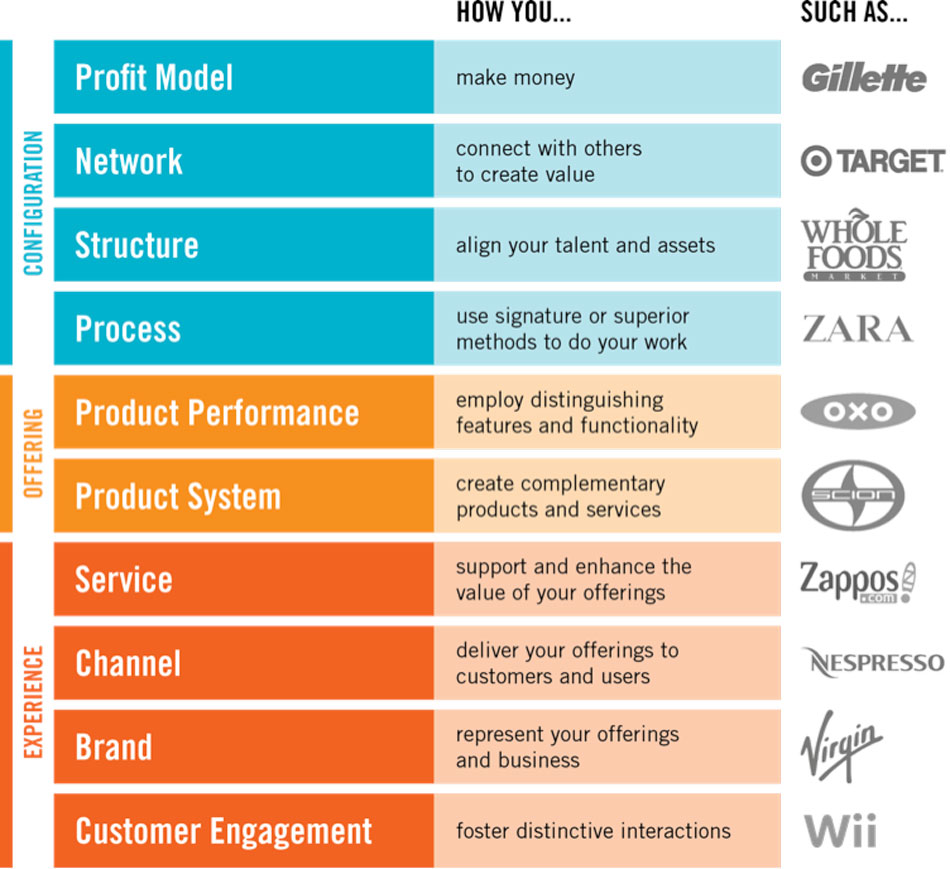Ten Types of Innovation: The Discipline of Building Breakthroughs

- Ten Types of Innovation: The Discipline of Building Breakthroughs
- Author: Larry Keeley, Ryan Pikkel, Brian Quinn and Helen Walters
- Publisher: John Wiley & Sons
- Publication date: 2013
Q: What’s the best way to fail at innovation?
A: Do product innovation.
This is the controversial message of a new hot book on innovation that’s getting glowing reviews – 10 Types of Innovation by innovation experts Larry Keeley and colleagues.
When doing innovation, particularly breakthrough innovation, we need to move beyond product innovation, because products rarely add value – most fail, and those that don’t get copied – fast.
Imitation has always been a problem, but technology has given imitators the upper hand; they can now deliver quality clones, faster, easier and more inexpensively than ever. The result is that product innovation is ‘nearly useless’ as a strategy for creating and capturing value.
So what’s an innovator to do? 10 Types of Innovation outlines 9 more valuable innovation alternatives to product innovation based on an analysis of some 2000 innovations:
- Profit Model Innovation: Innovating how you make money. Could you use bundled or flexible pricing, financing, advertising revenue, membership, metered or subscription models? For example, Gillette sells premium razors at a loss, but makes money on repeat sales of blades.
- Network Innovation: Innovating who you innovate with. Could you work with new or unique partners and suppliers to create and deliver value? Think open innovation, outsourcing, supply-chain integration, joint-ventures and collaborations. For example, discount retailer Target profited from network innovation by teaming up with leading designers for lines of affordable designed goods and fashions
- Structure Innovation: Innovating how you organise and align your organisation, talent and assets to create more value. Could you outsource where you don’t create or capture value, or could you integrate or cluster units or departments? For instance, Whole Foods premium supermarket chain uses radical decentralization that enables each store to operate autonomously to better meet store customer needs.
- Process Innovation: Innovating with a signature and superior method for creating value. Could you use on-demand or lean production, flexible manufacturing, or process standardization? Zara famously used process innovation to deliver a “from sketchpad to shop floor in three weeks”.
- Product Performance Innovation: Innovating products that work better to deliver superior value to buyers. Could you develop unique product features and functionality that captivate customers by making by helping them do more, with more style, speed, safety, ease or fun? For example, OXO used product performance innovation to create Good Grips, attractive and easy to use kitchen utensils based on universal design principles that sell for five times the price of competitors. The line now includes an OXO Good Grips surgical syringe.
- Product System Innovation: Innovating by creating complementary products and services that connect or bundle together to create more value. Could you or a partner create additional related, modular or peripheral products or services? For example, Toyota in the US through its sub-brand Scion, offers highly customisable cars with a suite of add-ons and accessories from Toyota and partners. Oscar Mayer has a similar supermarket offer through ‘Lunchables’, modular lunch packs for kids at school.
- Service Innovation: Innovating by adding value in how you support customers find, buy, pay, enjoy and dispose of your product. Could you offer a service concierge, sampling service, personalised service, delivery and returns service, financing service, self-service, or adjunct services such as warranties, repairs and guides? Zappos made service innovation a hero and consistently delivered a ‘WOW’ service that prompted Amazon to buy the startup with service know-how for $1.1 billion.
- Channel Innovation: Innovating how you deliver your offerings to customers and users. Could you use B2B, B2C or P2P channels, or harness pop-up stores, e-commerce stores, partner stores, or outlet stores? Nespresso is the poster child for channel innovation, creating a vertically integrated solution for coffee lovers that bypasses third-party retailer. Since 1996, Nespresso B2B channel includes The Ritz-Carlton and Hyatt Hotels, British Airways, Lufthansa, Qantas Airways and 650 star-rated chefs. Similarly Amazon’s channel innovation includes Whispernet, a private wireless network that is free for customers to deliver e-books, music and films.
- Brand Innovation: Innovating how you present your offerings and business in a distinctive, memorable, and likeable way. Could you brand offerings differently, using co-branding, umbrella branding, own-label branding, certification, distinctive marketing campaigns, novel brand extensions, or new packaging or design? For example, Virgin, which describes itself as an “international investment group” brands products and services distinctively by injected a much-needed dose of fun.
- Customer Engagement Innovation: Innovating how you foster compelling interactions. Could you a more personalised, rewarding or ‘humanised’ interaction, listen to customers rather than talk at them, or foster collaboration between customers themselves, or connect them with the causes, celebrities or communities they value? For example, Blizzard Entertainment’s World of Warcraft, is a massively multiplayer online role-playing game that connects and fosters collaboration between players.
The BG Take
For an agency that makes its living doing product innovation, 10 Types of Innovation is a challenge. Sure, there’s more to innovation that product innovation, but from a consumer perspective products (and services) are what people pay for. The product is where the value transaction takes place. The kinds of non-product innovation discussed in 10 Types are more about innovating for competitive advantage, not consumers – important certainly, but quite often irrelevant to consumers who buy stuff. They don’t care about your networks, profit model, structures etc – they just want stuff.
So whilst 10 Types is a useful lesson that we may not see the innovation wood for the product tree, we think the authors over-egg the case for non-product innovation. From what we see in just about every market, the product is becoming more important, not less important. Consumer are less loyal to brands and habits, and manufacturers live or die by product execution. One mess up is all it takes. So product innovation may no be the whole story, but it’s certainly a critical one.




